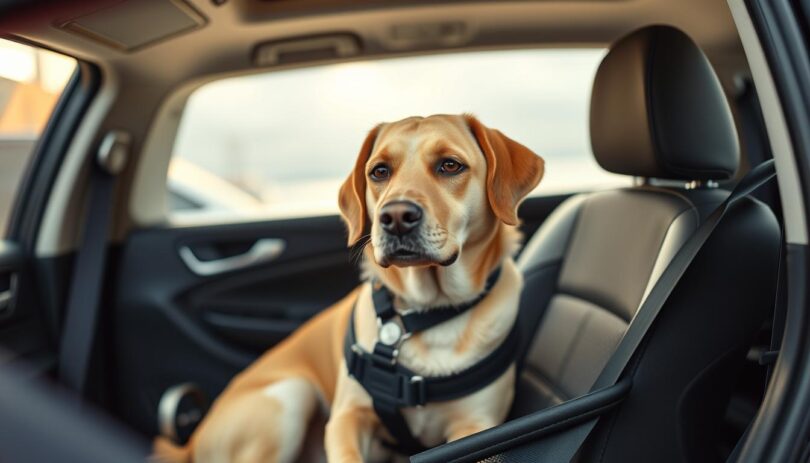On a mild 70°F day, temperatures inside parked vehicles can soar to 104°F within 20 minutes. This alarming fact highlights why leaving pets unattended in cars remains one of the most preventable risks to animal health.
Many owners underestimate how quickly enclosed spaces become dangerous. A vehicle’s metal frame and glass windows act like a greenhouse, trapping heat even during cloudy weather. Cracking windows open provides minimal relief, offering false security for concerned pet parents.
Common scenarios like quick errands or shaded parking spots often lead to tragic consequences. Dogs regulate body temperature less efficiently than humans, making them vulnerable to heatstroke within minutes. Their safety depends entirely on proactive planning and awareness.
This guide explores practical strategies for protecting furry companions during travel. Readers will learn how to recognize warning signs, create emergency protocols, and choose pet-friendly alternatives to risky situations. Simple precautions can mean the difference between a close call and a life-threatening crisis.
Understanding the Risks of Leaving Dogs in Cars
Many pet owners underestimate how vehicles transform into heat traps. Research from San Francisco State University reveals parked cars reach dangerous temperatures faster than most realize – 70°F outside becomes 89°F inside within 10 minutes.
The Greenhouse Effect in Action
Glass windows and metal frames amplify heat retention. This greenhouse effect causes interior temperatures to climb 3-4°F every five minutes. At 85°F ambient heat, cabins can hit 120°F in 15 minutes – faster than a microwave heats leftovers.
Myths Versus Reality
Contrary to “quick errand” assumptions, 10 minutes in 90°F conditions proves fatal for many pets. Canines cool through panting, which fails in stagnant air. Dehydration and heatstroke develop rapidly as body temperatures exceed 104°F.
Veterinary reports show 80% of heat-related pet emergencies involve unattended vehicles. Owners often return to find companions disoriented or unconscious. Unlike humans, furry friends lack efficient cooling systems to handle extreme environments.
Never leave companions alone in parked cars – shaded spots and open windows offer false security. Plan routes with pet-friendly stops or keep travel partners at home during warm weather.
The Science Behind Car Heat and Dog Physiology
Metal and glass transform stationary cars into rapid-heating chambers, endangering canine passengers. Vehicles absorb sunlight through windows while trapping infrared radiation – a process called the greenhouse effect. This creates conditions where internal temperatures consistently outpace outdoor readings.
Material Matters in Heat Trapping
Automotive glass allows 80% of solar radiation to enter but blocks 90% from escaping. Combined with metal surfaces that conduct heat, cabins become ovens. At 75°F outside, temperature inside reaches 94°F in 10 minutes. After 30 minutes, mercury climbs to 113°F – hot enough to fry eggs on dashboard surfaces.
Temperature Escalation Patterns
Studies by climatologist Jan Null show dangerous thresholds develop rapidly. When ambient air hits 85°F, inside car measurements spike 19°F within 10 minutes. Every additional minute adds 3-4°F. Shaded parking only delays heating by 15 minutes before matching sun-exposed vehicles.
Dogs struggle in these environments due to biological limitations. Their primary cooling method – panting – becomes ineffective when air temperatures exceed body heat. Thick fur coats and limited sweat glands accelerate overheating risks as cabin degrees climb.
Understanding these physical principles helps owners anticipate dangers. Vehicles heat faster than panting can compensate, creating life-threatening conditions in under 15 minutes during warm weather.
Is it ok to lock a dog in a car?
Common assumptions about car safety for animals often clash with scientific reality. Many owners believe certain precautions make leaving dog companions briefly acceptable, but veterinary experts unanimously disagree.
Myth-Busting: The Truth About Vehicle Safety
“Just five minutes” ranks as the most dangerous misconception. A 2023 study by the American Veterinary Medical Association found 63% of heatstroke cases occurred when owners stepped away for under 10 minutes. Cracked windows reduced interior temperatures by only 2-3°F – meaningless when heat climbs 19°F in that timeframe.
Shaded parking spots and cool mornings provide false comfort. Dr. Emily Blackwell, a veterinary thermoregulation specialist, notes: “Metal vehicles heat rapidly regardless of initial conditions. Leaving dog companions alone here risks organ failure within minutes.”
Three critical facts every owner should know:
• Panting becomes ineffective when cabin air exceeds 100°F
• Dehydration accelerates faster in confined spaces
• Brain damage starts at 106°F body temperature
Ensuring pets safe means never using “quick stops” as justification. Modern solutions like pet-friendly stores or travel buddies eliminate the need to leave pet companions unattended. When planning errands, prioritize furry friends’ needs first – their survival depends on it.
Legal Implications and State Laws
Twenty-eight states now recognize leaving pets in vehicles as a criminal offense under specific conditions. Legal protections for animal life in cars have expanded significantly since 2018, with 16 states adopting “necessary defense” laws allowing bystanders to rescue distressed companions.
Legislative Landscape Across America
California leads with strict penalties: $500 fines and 6-month jail terms for first offenses. Tennessee allows animal control officers to break windows without liability when pets show heat distress. Illinois mandates veterinary costs coverage for rescued animals through owner reimbursement.
Penalty Variations and Enforcement
While many states treat first offenses as misdemeanors, repeat violations escalate to felonies in 9 jurisdictions. Florida imposes $5,000 fines for multiple incidents involving severe harm. Twelve states grant civil immunity to rescuers who damage vehicles during emergency interventions.
Key legal considerations for owners:
• 34 states prohibit confinement that risks health/safety
• 22 states define specific temperature thresholds
• 7 states require posted warnings at parking areas
Report neglected pets by contacting local law enforcement or 911 – many states mandate immediate response. Document conditions with photos/videos while awaiting authorities. Understanding these laws helps protect both animals and responsible owners from legal consequences.
Recognizing the Signs of Heatstroke in Dogs
Spotting early heatstroke symptoms can save a dog’s life within minutes. Unlike humans, canines struggle to cool down once their body temperature escalates. Recognizing critical warning signs allows owners to act before irreversible damage occurs.
Early Symptoms and Indicators
Normal canine body temperature ranges from 101°F to 102.5°F. Watch for rapid panting, brick-red gums, and thick drool during warm weather. As heat stress progresses, pets may show dizziness, vomiting, or collapse. The tongue often darkens to purple as oxygen levels drop.
Advanced stages bring alarming changes:
• Glassy eyes and unresponsiveness
• Staggering movements or seizures
• Rectal readings above 104°F
Why Prompt Action Is Critical
Heatstroke becomes fatal when body temperature hits 106°F. Organ failure starts within 30 minutes at this threshold. Immediate cooling measures and veterinary care improve survival chances by 80%, according to ASPCA data.
Follow these steps if symptoms appear:
1. Move the pet to shade immediately
2. Apply cool (not cold) water to paw pads and groin
3. Offer small sips of water
4. Contact emergency vet services
Monitoring pet health during summer outings prevents tragedies. Owners who recognize these signals often make life-saving decisions before temperatures turn deadly.
Emergency Steps if You Find a Dog in a Hot Car
Every second counts when encountering an animal trapped in a sweltering vehicle. Immediate action can prevent irreversible harm or death. Follow these expert-recommended steps to respond effectively while staying within legal boundaries.
Contact Authorities and Secure Assistance
Dial 911 or the ASPCA hotline (888-426-4435) first. Note the vehicle’s make, model, and license plate while waiting. Many states permit breaking windows in emergencies, but always verify local laws before intervening. Stay calm – agitated pets may bite due to stress.
Stabilize the Animal Safely
Move the pet to shade immediately after rescue. Apply cool (not cold) water to paw pads, ears, and groin – avoid ice packs that constrict blood flow. Offer small sips of room-temperature water every five minutes. Never force liquids if the animal appears disoriented.
Critical post-rescue steps:
- Monitor breathing patterns for irregularities
- Check gum color – pale or blue indicates oxygen deprivation
- Wrap in damp towels during transport to veterinary care
Veterinary partners recommend documenting the situation with photos while assisting. This protects both rescuer and animal during legal follow-ups. Remember – parked vehicles become death traps faster than most realize, making swift action essential.
Car Travel Safety Tips for Your Pet
Traveling with pets requires careful preparation to ensure their safety and comfort on the road. Simple measures like proper restraints and climate control can prevent accidents and health risks. Pet owners should prioritize these strategies to create stress-free journeys for their companions.
Restraint Systems and Proper Harnesses
Crash-tested harnesses reduce injury risks by 85% compared to loose pets in vehicles, according to Petfinder. Choose products certified by the Center for Pet Safety, ensuring snug fits without restricting movement. Hard-sided carriers anchored with seatbelts offer added protection for smaller animals.
Keeping Your Pet Cool During Stops
Schedule breaks every 1-2 hours to provide water and shade. Portable cooling mats or damp towels help lower body temperatures quickly. Crack windows slightly when parked, but never leave companions alone – even briefly. Studies show 60% of heat-related incidents occur during “quick” errands.
Three essential tips for safer trips:
• Test vehicle ventilation before long drives
• Freeze water bowls for gradual melting during travel
• Use sunshades on side windows to block direct heat
Planning routes with pet-friendly rest areas ensures access to fresh air and hydration. Always monitor furry friends for signs of discomfort, adjusting plans if needed. Remember: a parked car becomes dangerous faster than most realize, making proactive measures vital for every adventure.
Keeping Your Dog Safe: Final Best Practices for Pet Owners
Protecting furry companions requires consistent, informed action across all travel scenarios. Follow these science-backed strategies to prioritize animal welfare and comply with safety laws.
Essential Safety Checklist
• Monitor outdoor temperatures using reliable thermometers – 70°F outside means 100°F+ inside vehicles
• Use crash-tested harnesses or carriers during every car ride
• Research local animal protection laws before traveling
• Plan routes with shaded rest stops and pet-friendly businesses
Weather extremes demand extra vigilance. Summer heat pushes cabin temperatures 30°F above outdoor readings within minutes. Winter conditions create hypothermia risks when engines shut off. Always bring water bowls and cooling mats for climate control.
Legal consequences reinforce responsible choices. Twenty-eight states penalize leaving animals in dangerous conditions. Familiarize yourself with regional regulations to avoid fines or criminal charges.
Commit to lifelong pet safety by sharing these practices with fellow owners. Bookmark veterinary emergency contacts and refresh prevention knowledge annually. Together, we can protect countless dogs from preventable harm.
FAQ
How fast does a parked car become dangerous for pets?
Vehicle interiors can reach lethal temperatures within 10 minutes, even with mild 70°F weather. Cracking windows provides minimal relief as heat buildup accelerates rapidly in enclosed spaces.
What emergency steps should I take for a distressed animal in a vehicle?
Immediately contact local law enforcement or animal control. Document the situation with photos/video while waiting for responders. If legal in your state, break windows only as a last resort after official authorization.
Are there legal protections for pets left in unattended cars?
31 states have specific laws against leaving animals in vehicles under dangerous conditions. Penalties range from fines to felony charges, with California and Texas allowing citizen rescues under Good Samaritan provisions.










Leave a Comment